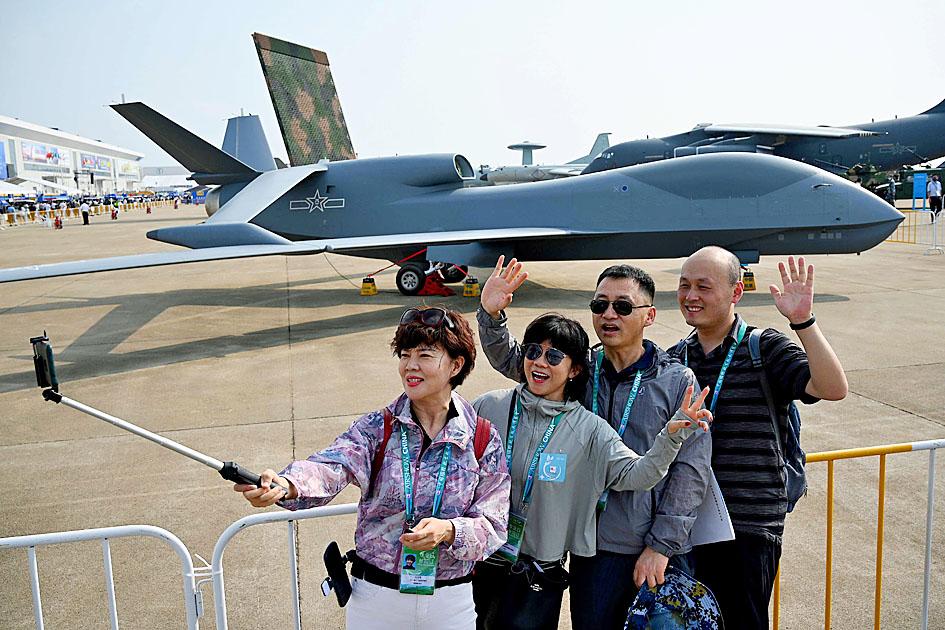China yesterday showed off its increasingly sophisticated air power, including surveillance drones, with an eye on disputed territories from Taiwan to the South China Sea and its rivalry with the US.
The nation’s biggest airshow, in the southern coastal city of Zhuhai, comes as Beijing pushes to meet a 2035 deadline to retool its military for modern warfare.
China still lags the US in terms of technology and investment in its war machine, but experts say it is narrowing the gap.

Photo: AFP
A US intelligence report this year flagged China’s growing influence as one of Washington’s biggest threats.
An air force aerobatic team left colorful vapor trails as it maneuvered in formation, while visitors inspected new jets, drones and attack helicopters on the tarmac.
The CH-6, a prototype drone with a wingspan of 20.5m, was among the domestic technology unveiled.
It is designed for surveillance and can also carry weapons for strike missions, open-source intelligence agency Janes reported.
The drone has a cruising altitude of 10,000m, “but it can go as high as 15,000m,” said Qin Yongming, general manager of drone maker Aerospace CH UAV Co.
“It can fly for longer periods [than previous models] ... it can carry out longer missions, with higher efficiency without any time limits,” Qin said.
Other debutants included the WZ-7 high-altitude drone for border reconnaissance and maritime patrol, as well as the J-16D fighter that has the ability to jam electronic equipment.
Both have already entered service with the air force, state media reported.
“They will play a major role in both the Taiwan Strait and the South China Sea,” military commentator Song Zhongping (宋忠平) said.
Under former US president Donald Trump, Washington authorized about US$18 billion of arms sales to Taiwan, including advanced missile platforms — sales that angered Beijing.
China is also “clearly positioning itself to be an alternative supplier” of advanced drones, with relative affordability, Janes analyst Kelvin Wong (黃加榮) said.
The US and European nations have been hesitant to supply such equipment outside a select group of partners, he said.
Chinese drones have already seen combat action in the Middle East and have been sold to customers in other regions as well.
The J-16D improves the combat capabilities of the People’s Liberation Army, said James Char, a Chinese military expert at Singapore’s Nanyang Technological University.
The jet has wingtip pods to disrupt enemy electronic equipment and has drawn comparisons with the US-made EA-18G Growler.
“It gives the Chinese military an advantage in terms of conducting aerial electronic warfare over targets that possess significant air defense capabilities,” Char said.
The Zhuhai airshow, usually held every two years, was postponed from last year due to the COVID-19 pandemic, and is being staged before a largely domestic audience due to quarantine and travel restrictions.

MISINFORMATION: The generated content tends to adopt China’s official stance, such as ‘Taiwan is currently governed by the Chinese central government,’ the NSB said Five China-developed artificial intelligence (AI) language models exhibit cybersecurity risks and content biases, an inspection conducted by the National Security Bureau (NSB) showed. The five AI tools are: DeepSeek, Doubao (豆包), Yiyan (文心一言), Tongyi (通義千問) and Yuanbao (騰訊元寶), the bureau said, advising people to remain vigilant to protect personal data privacy and corporate business secrets. The NSB said it, in accordance with the National Intelligence Services Act (國家情報工作法), has reviewed international cybersecurity reports and intelligence, and coordinated with the Ministry of Justice Investigation Bureau and the National Police Agency’s Criminal Investigation Bureau to conduct an inspection of China-made AI language

LIMITS: While China increases military pressure on Taiwan and expands its use of cognitive warfare, it is unwilling to target tech supply chains, the report said US and Taiwan military officials have warned that the Chinese People’s Liberation Army (PLA) could implement a blockade within “a matter of hours” and need only “minimal conversion time” prior to an attack on Taiwan, a report released on Tuesday by the US Senate’s China Economic and Security Review Commission said. “While there is no indication that China is planning an imminent attack, the United States and its allies and partners can no longer assume that a Taiwan contingency is a distant possibility for which they would have ample time to prepare,” it said. The commission made the comments in its annual

‘TROUBLEMAKER’: Most countries believe that it is China — rather than Taiwan — that is undermining regional peace and stability with its coercive tactics, the president said China should restrain itself and refrain from being a troublemaker that sabotages peace and stability in the Indo-Pacific region, President William Lai (賴清德) said yesterday. Lai made the remarks after China Coast Guard vessels sailed into disputed waters off the Senkaku Islands — known as the Diaoyutai Islands (釣魚台) in Taiwan — following a remark Japanese Prime Minister Sanae Takaichi made regarding Taiwan. Takaichi during a parliamentary session on Nov. 7 said that a “Taiwan contingency” involving a Chinese naval blockade could qualify as a “survival-threatening situation” for Japan, and trigger Tokyo’s deployment of its military for defense. Asked about the escalating tensions

DISPUTE: A Chinese official prompted a formal protest from Tokyo by saying that ‘the dirty head that sticks itself out must be cut off,’ after Takaichi’s Taiwan remarks Four armed China Coast Guard vessels yesterday morning sailed through disputed waters controlled by Japan, amid a diplomatic spat following Japanese Prime Minister Sanae Takaichi’s comments on Taiwan. The four ships sailed around the Senkaku Islands — known as the Diaoyutai Islands (釣魚台) to Taiwan, and which Taiwan and China also claim — on Saturday before entering Japanese waters yesterday and left, the Japan Coast Guard said. The China Coast Guard said in a statement that it carried out a “rights enforcement patrol” through the waters and that it was a lawful operation. As of the end of last month,